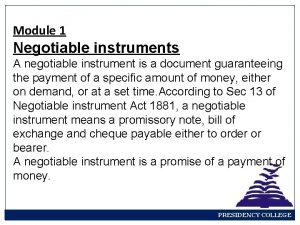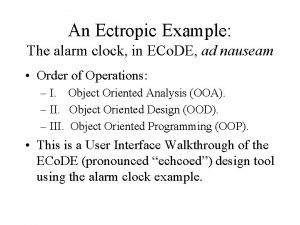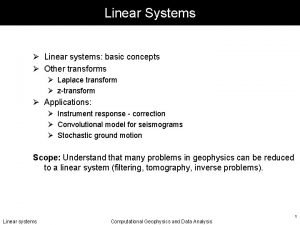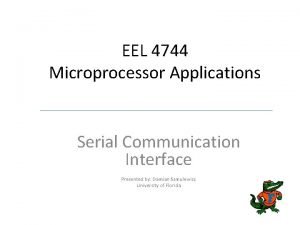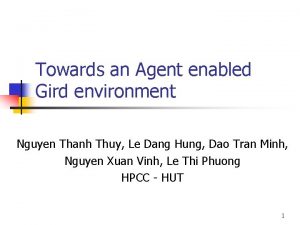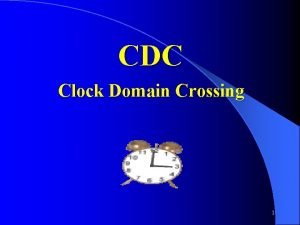EEL 4712 Digital Design Clock Domain Crossing CDC

























- Slides: 25

EEL 4712 Digital Design (Clock Domain Crossing)

CDC Overview l As modern System-on-Chip (So. C) designs continue to face increasing size and complexity challenges Multiple asynchronous clock domains have been employed for different I/O interfaces. u l A CDC-based (Clock Domain Crossing) design is a design that has one clock asynchronous to, or has a variable phase relation with, another clock. 2

l For example, a clock and its derived clock (via a clock divider) are in the same clock domain because they have a constant phase relationship. l CLK, its inversion, and D 1 (derived from CLK) are synchronous to each other. l But, 50 MHz and 37 MHz clocks (whose phase relationship changes over time) define two separate clock domains. 3

l A clock domain crossing signal is a signal from one clock domain that is sampled by a register in another clock domain. l Within one clock domain, proper static timing analysis (STA) can guarantee that data does not change within clock setup and hold times. When signals pass from one clock domain to another asynchronous domain, there is no way to avoid meta-stability since data can change at any time. 4

Meta-stability l Every flip-flop (FF) that is used in any design has a specified setup and hold time, or the time in which the data input is not legally permitted to change before and after a sampling clock edge. 5

6

l In a multi-clock design, meta-stability is inevitable, but there are certain design techniques that help to avoid the chance of getting meta-stable. l The main responsibility of a synchronizer is to allow sufficient time such that any meta-sable output can settle down to a stable value in the destination clock domain. 7

Synchronization of Control Signals with 2 FF Synchronizers l The most common synchronizer used by designers is two-flip-flop (2 -FF) synchronizers. Usually the control signals in a design are synchronized by 2 -FF synchronizers. l Even if a 2 -FF synchronizer helps to prevent propagation of meta-stable values, for the correct operation of the design, some other issues needs to be tackled. 8

Input Data Stability to Avoid Data Loss l Every transition on the input signal needs to be correctly propagated to the destination domain. l The input signal needs to hold its value a minimum amount of time such that there is at least a single destination sampling clock edge, which samples the input value correctly (No setup/hold violation) 9

Gray Encoding to Avoid Data Incoherence the natural way to transfer a vector control signal is to model each bit of the vector to be separately synchronized by a FF synchronizer. Sig wants to change its value from "000" to "101" (both indicate valid states). However, it ends up in invalid state “ 100”. 10

Gray Encoding to Avoid Data Incoherence l Use Gray code when crossing a clock domain boundary. l A Gray code ensures that only a single bit changes as the bus counts up or down. l The presence of gray coding on vector control signal can be checked by using assertions. For more information, see the section "Gray Code Encoding for Vector Control Signals". 11

Synchronization of CDC Data Signals l It is challenging to ensure transfer of data buses from one clock domain to another. l The individual bits of a data bus can change randomly while changing clock boundaries. l Using synchronizers/gray code to handle the passing of data bus is generally unacceptable. l Three common methods u Using MUX based synchronizers. u Using Handshake signals. u Using FIFOs (First In First Out memories) to store data with one clock domain and to retrieve data with another clock domain. 12

Using MUX based synchronizers 13

Handshaking Data between Clock Domains 14

Passing Data by FIFO between Clock Domains 15

User-defined Synchronizers 16

Structural Analysis to Identify CDC Signals l The most important task of any CDC structural analyzer is to find out all the signals (CDC) that cross clock boundaries. 17

Convergence in the Crossover Path 18

Divergence in the Crossover Path l Design styles which allow divergent logic on a CDC signal to multiple synchronization paths, may cause functional errors. 19

Divergence of Meta-stable Signal l Using a meta-stable signal in a design can be erroneous. Therefore multiple fan-out of the output of the first FF of a FF synchronizer can cause functional errors. 20

convergence of Synchronized Signals l When a signal goes meta-stable, a synchronizer settles it down, but cannot guarantee the precise number of cycles before the valid signal is available in the receiving clock domain. 21

Conclusion l A CDC signal is a signal latched by a flip-flop (FF) in one clock domain and sampled in another asynchronous clock domain. l Transferring signals between asynchronous clock domains may lead to setup or hold timing violations of flip-flops. l These violations may cause signals to be meta-stable. 22

Conclusion l Even if synchronizers could eliminate the metastability, incorrect use, such as convergence of synchronized signals or improper synchronization protocols, may also result in functional CDC errors. l Functional validation of such So. C designs is one of the most complex and expensive tasks. l Simulation on register transfer level (RTL) is still the most widely used method. However, standard RTL simulation can not model the effect of meta-stability. 23

References l https: //filebox. ece. vt. edu/~athanas/4514/leda doc/html/pol_cdc. html 24

Questions?
 Eel 4712
Eel 4712 Sans recourse endorsement
Sans recourse endorsement Compte 4712 ohada
Compte 4712 ohada Fast clock to slow clock synchronization
Fast clock to slow clock synchronization 1 hour =60 minutes
1 hour =60 minutes Class diagram for digital alarm clock
Class diagram for digital alarm clock Comp 345
Comp 345 Domain co domain and range of a relation
Domain co domain and range of a relation Z domain to frequency domain
Z domain to frequency domain Fourier series of trapezoidal waveform
Fourier series of trapezoidal waveform Time reversal z transform
Time reversal z transform Inverse z transform table
Inverse z transform table Domain specific vs domain general
Domain specific vs domain general Domain specific vs domain general
Domain specific vs domain general Problem domain vs knowledge domain
Problem domain vs knowledge domain S domain to z domain
S domain to z domain Application domain and execution domain
Application domain and execution domain Arthur kipps quotes
Arthur kipps quotes Gulper eel habitat
Gulper eel habitat Tripod fish
Tripod fish Eel 3801 lab manual
Eel 3801 lab manual Eel gird
Eel gird Rahvusvahelised suhted
Rahvusvahelised suhted Eel 3705
Eel 3705 Usp
Usp Piezolytes
Piezolytes

